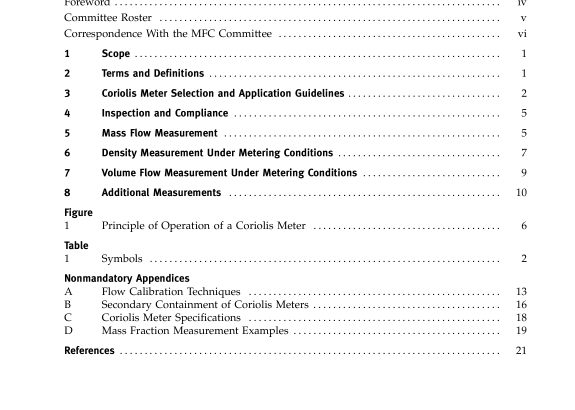ASME MFC-11M-2003 pdf free download.MEASUREMENTOF FLUID FLOWBY MEANS OFCORIOLIS MASS FLOWMETERS
3.3 Physical Installation
3.3.1 General. The manufacturer should describe the preferred installation arrangement and state any restrictions of use. See Appendix C. If needed, strainers, filters, air, and/or vapor eliminators or other protective devices should be placed upstream of the meter for the removal of solids or vapors that could cause damage or induce errors in measurement. Coriolis meters are generally placed in the mainstream of the flow but can also be placed in a bypass arrangement for density measure- ments.
3.3.2 Installation Criteria. Consideration should be given to the following points:
(a) the space required for the Coriolis meter installation, including provision for external prover or mastermeter connections, should in situ calibration be required
(b) the class and type of pipe connections and materials, aswell asthedimensions oftheequipmentto be used
(c) the hazardous area classification
(d) the environmental effects on the sensor (e.g., tem- perature, humidity, corrosive atmospheres, mechanical shock, vibration, and electromagnetic field)
(e) the mounting and support requirements 3.3.3 Full-Pipe Requirement. The meter performance is impaired if the tubes are not completely filled with the flowing fluid. The manufacturer may be consulted for information on the meter’s performance and possible methods to purge or drain gases and/or liquids from the sensor.
3.3.4 Orientation. Forproperoperation, the flow sen- sor should be mounted such that the oscillating tube(s) remain completely filled with the process fluid while the fluid is being metered. Plugging, coating, trapped gas, or settling of solids can affect the meter’s perform- ance. The orientation of the primary device will depend on the application as well as the geometry ofthe oscillat- ing tube(s).
3.3.5 Flow Conditions and Straight Length Require- ments. The performance of substantially bent bending- mode Coriolis flowmeters are generally not affected by velocity profile or fluid swirl. Straight piping lengths adjacent to the meter are not typically required. Some slightly bent Coriolis meters may be affected by velocity profile and swirl, so the Coriolis meter manufacturer’s information should be consulted for specific require- ments.
3.3.6 Valves. Valves upstream and downstream of a Coriolis meter, installed for the purpose of isolation 3 and zero adjustment, can be of any type, but should provide tight shutoff. Control valves in series with a Coriolis meter should be installed downstream in order to maintain a higher pressure in the meter and thus reduce the chance of cavitation or flashing.
3.3.7 Cleaning. For certain applications the Coriolis meter may require in situ cleaning, which, depending on design, may be accomplished by
(a) mechanical means (using a pig or ultrasonically)
(b) self-draining
(c) hydrodynamic means:
(1) sterilization [steaming-in-place, (SIP)]
(2) chemical or biological [cleaning-in-place, (CIP)] NOTES: (1) Care should be taken to avoid cross-contamination after clean- ing fluids have been used. (2) Chemical compatibility should be established between the sen- sor wetted-materials, process fluid, and cleaning fluid.
3.3.8 Hydraulic and MechanicalVibrations. The man- ufacturer shall provide the mechanical operating fre- quency of the instrument to enable assessment of possi- ble influence of process or other external mechanically imposed vibration frequencies. It is possible that the performance of the meter may be influenced by vibra- tions atother than the operating tube frequency. Consul- tation with the manufacturer may be appropriate if vi- bration problems are anticipated or if they occur. In environments with high mechanical vibrations or flow pulsation, consider the use of isolation or pulsation damping devices (see para. 3.4.7). It is advised to consult the manufacturer for guidance in this case.
3.3.9 Flashing and/or Cavitation. The relatively high fluid velocities, which may occur in Coriolis meters, cause local dynamic pressure drops inside the meter, which may result in flashing and/or cavitation. Both flashing and cavitation in Coriolis meters (and immedi- ately upstream and/or downstream of them) should be avoided. Flashing and cavitation may cause measure- ment errors and may damage the sensor.ASME MFC-11M pdf download.ASME MFC-11M-2003 pdf free download
